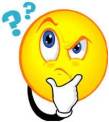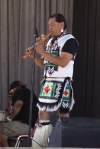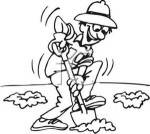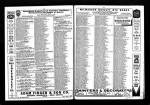 Have you ever come upon an ancestor whose last name is slightly different from their parents? Names like “John/Johnson, Anders/Anderson or perhaps, Issac/Isaacson”? Cultures that traditionally used patronymic family names gave the child the father’s first name then added the word son to it. In Norway, each son of Anders was an “Andersen” and every daughter was an “Andersdatter”.
Have you ever come upon an ancestor whose last name is slightly different from their parents? Names like “John/Johnson, Anders/Anderson or perhaps, Issac/Isaacson”? Cultures that traditionally used patronymic family names gave the child the father’s first name then added the word son to it. In Norway, each son of Anders was an “Andersen” and every daughter was an “Andersdatter”.
The first known Patronymic naming of a child was in 1612. It became a very popular custom for those who had ventured to the New World. Many of the immigrants came seeking a new life or a new start so with that came a new variation of their name. I have one such ancestor name, John Dods. He was born in Great Neck, Yorkshire, England in 1571. He arrived in Jamestown, Virginia in 1607 and married a woman named Jane shortly after that. When they began to have children (I only have proof of 2 sons) the boys were named Jesse and Benjamin Dodson.
Following this principle, I started doing some research into other cultures naming traditions. Basically, I was hoping to find any information about one of my brick wall ancestors, Jane Virtchworth. There is absolutely no documentation to be found for her. The source of Jane’s name appears to be a private letter written more than 100 years ago which stated, “Benjamin Goodin came from Wales and settled in Baltimore, Md ca 1750. He was m in Va in 1762 to Jane Virtchworth. He d. aged 101”. This information comes from “Descendants of James (Timothy) McClintock and Some Related Families…” by A. Louise (McClintock) Shelton, published in 1985. See footnote on page 19 for more details regarding the source of this letter. So during my research, I came across the following information:
Among the Welsh, every male child of David would be an “ap David” and every daughter a, “virtch David”. Using this information we could assume that Jane Virtchworth was really Jane virtch Worth. Her father’s first name was “Worth” and his family name — a patronymic — would have been “ap [what ever his father’s first name was]”. So my next step will be to search records in the Culpeper County, VA, and the Maryland area sometime between 1750 and 1762 to see if there may be an immigrant who arrived from Wales and has the first name of Worth with a daughter named Jane. This will be a tedious task and there is no guarantee that this method will work. However, I believe it would be worth a try.
daughter a, “virtch David”. Using this information we could assume that Jane Virtchworth was really Jane virtch Worth. Her father’s first name was “Worth” and his family name — a patronymic — would have been “ap [what ever his father’s first name was]”. So my next step will be to search records in the Culpeper County, VA, and the Maryland area sometime between 1750 and 1762 to see if there may be an immigrant who arrived from Wales and has the first name of Worth with a daughter named Jane. This will be a tedious task and there is no guarantee that this method will work. However, I believe it would be worth a try.
I wonder how many other “Freaky” ways of attempting to tear down brick walls there are?
I am a professional genealogist, writer, photographer, wife, mother, and grandma. I have two books available on Amazon.com: Your Family History: Doing It Right the First Time and Planning Your Genealogy Research Trip. You can also connect with me via Facebook or Twitter.

 Francis McGowan is my 3x Great Grandfather and he is also one of my solid brick walls. He was born in Dublin County, Ireland sometime around 1794. He came to America in 1810 and he filed a Common Plea for naturalization on March 3, 1811, in Philadelphia Pennsylvania. After this, he is found living in Monroe County, Tennessee. He eventually married Margaret “Peggy” Divine sometime before 1829 and they had 9 children between 1830 and 1844. He died in April 1871 in Monroe County, Tennessee.
Francis McGowan is my 3x Great Grandfather and he is also one of my solid brick walls. He was born in Dublin County, Ireland sometime around 1794. He came to America in 1810 and he filed a Common Plea for naturalization on March 3, 1811, in Philadelphia Pennsylvania. After this, he is found living in Monroe County, Tennessee. He eventually married Margaret “Peggy” Divine sometime before 1829 and they had 9 children between 1830 and 1844. He died in April 1871 in Monroe County, Tennessee.
 My maternal Great Grandparents Pleasant Smith and Sarah Jane Page had been a solid brick wall since I began researching over 20 years ago. Basically, all I had to go on were their names and dates of birth that had been handwritten in my baby book. I had one story about my Pleasant that my mother had told me while growing up, however, it was a wild tale that will probably never be proven. I spent so much time searching for Pleasant that I rarely looked for Sarah, but when I did nothing came up.
My maternal Great Grandparents Pleasant Smith and Sarah Jane Page had been a solid brick wall since I began researching over 20 years ago. Basically, all I had to go on were their names and dates of birth that had been handwritten in my baby book. I had one story about my Pleasant that my mother had told me while growing up, however, it was a wild tale that will probably never be proven. I spent so much time searching for Pleasant that I rarely looked for Sarah, but when I did nothing came up. find anything I would get frustrated and move on to my dad’s side of the family. So I began with renewed focus and determination. For weeks I searched using variations of her name, her date, and place of birth and the estimated date of marriage using my Grandfather’s birth date. I searched on many different sites but to no avail. I don’t really remember what I did at the time but suddenly their marriage information popped up. Her name was listed as Sarah J. McDowell! She had been married before Pleasant. I quickly looked for her previous husband and after I verified the information I added his name to the tree. I was surprised at all the information I found.
find anything I would get frustrated and move on to my dad’s side of the family. So I began with renewed focus and determination. For weeks I searched using variations of her name, her date, and place of birth and the estimated date of marriage using my Grandfather’s birth date. I searched on many different sites but to no avail. I don’t really remember what I did at the time but suddenly their marriage information popped up. Her name was listed as Sarah J. McDowell! She had been married before Pleasant. I quickly looked for her previous husband and after I verified the information I added his name to the tree. I was surprised at all the information I found. 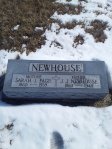 Sarah married the first time when she was 16 years old. I couldn’t find a divorce record so I researched her husband, James McDowell and found he had been remarried before Sarah married Pleasant so I assumed there had been a divorce. I mentioned earlier about the wild tale I was told about Pleasant, well maybe some of it had been true. I have never found a death record or any record for him after the birth of my Grandfather. What I did find was Sarah had been married a total of 4 times, once before Pleasant and twice afterward. Her last husband James Newhouse was her longest one with 44 years of marriage and it was also the one that led me to her Fathers name!
Sarah married the first time when she was 16 years old. I couldn’t find a divorce record so I researched her husband, James McDowell and found he had been remarried before Sarah married Pleasant so I assumed there had been a divorce. I mentioned earlier about the wild tale I was told about Pleasant, well maybe some of it had been true. I have never found a death record or any record for him after the birth of my Grandfather. What I did find was Sarah had been married a total of 4 times, once before Pleasant and twice afterward. Her last husband James Newhouse was her longest one with 44 years of marriage and it was also the one that led me to her Fathers name!
 This is the ancestor that I have the least amount of information about. There has been a lot of debates on Ancestry.com concerning her name, year of birth, and marriage. Let’s take a look at what I do know about her.
This is the ancestor that I have the least amount of information about. There has been a lot of debates on Ancestry.com concerning her name, year of birth, and marriage. Let’s take a look at what I do know about her.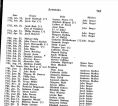 trees, I find it listed as Louise or Louisa. Some of them have the name, Louisa Lucy. I understand that there are different ways to spell names and Louise or Louisa could be another way of writing Lewisa. However, as of this writing, I only have one document pertaining to her and her name is Lewisa on it. I have never found anything with either of the other 2 spellings or with the middle name of Lucy. That brings us to the year of birth and the year she got married.
trees, I find it listed as Louise or Louisa. Some of them have the name, Louisa Lucy. I understand that there are different ways to spell names and Louise or Louisa could be another way of writing Lewisa. However, as of this writing, I only have one document pertaining to her and her name is Lewisa on it. I have never found anything with either of the other 2 spellings or with the middle name of Lucy. That brings us to the year of birth and the year she got married. I found one “record” of their marriage in the publication “A History of Shenandoah County, Virginia”. It states that they got married at the date listed above. It has her name spelled as “Lewisa”. However, there is a “U.S. and International Marriage Record” that has a Louise Bean marrying a John Parrett in 1861. If this was Lewisa she would have gotten married when she was 1 year old! Also, her last child was born in 1899 so calculating this she would have been anywhere between 55 to 60 years old when Catherine was born. One thing that people keep pointing out to me is the marriage month and day are the same on both “records”, just the year is different.
I found one “record” of their marriage in the publication “A History of Shenandoah County, Virginia”. It states that they got married at the date listed above. It has her name spelled as “Lewisa”. However, there is a “U.S. and International Marriage Record” that has a Louise Bean marrying a John Parrett in 1861. If this was Lewisa she would have gotten married when she was 1 year old! Also, her last child was born in 1899 so calculating this she would have been anywhere between 55 to 60 years old when Catherine was born. One thing that people keep pointing out to me is the marriage month and day are the same on both “records”, just the year is different. I am a professional genealogist, writer, photographer, wife, mother, and grandma. I have two books available on Amazon.com:
I am a professional genealogist, writer, photographer, wife, mother, and grandma. I have two books available on Amazon.com: 